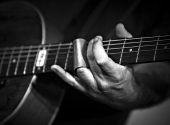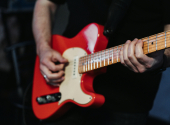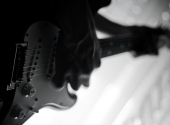
(Un)usual Guitar Techniques #4: Vibrato Bar
Vibrato bar, whammy bar or tremolo arm. Most guitarists immediately know what we're talking about. Yes, it's that strange thing sticking out of the guitar's bridge that allows you to smoothly change the pitch of the notes, and whose invention was one of the major milestones in the history of electric guitars. It's an inseparable part of the characteristic sound of many guitar giants which offers a wealth of possibilities.
But when I was talking to guitarists on a discussion forum the other day about using a vibrato bar in solos, I was honestly surprised by the large number of responses like "I don't even know where I even have one...", "I unscrewed it as soon as I bought the guitar..." or "Yeah, I've got that in my attic drawer!" Yet playing with a whammy bar is, at least in my opinion, one of the most fun things about playing an electric guitar. It gives guitar solos a whole new dimension. So if your bar is also resting somewhere in your closet, perhaps this article will inspire you to give it another shot.
Short introduction
The tremolo arm and the associated tremolo is a rather complex mechanism, which I will not explain in detail.
When playing with a vibrato bar, the quality and setup of your instrument
is more important than when using other techniques. When you're down-tuning or up-tuning the strings, especially if you venture into a bit wilder stunts, the mechanics of the guitar take a beating, and it quickly shows what kind of instrument you have in your hands. Nothing can discourage beginners from using the bar as much as the constant detuning of the guitar.
This was also the reason why I soon swapped my low-quality Stratocaster for a super-strat Jackson with a Floyd Rose tremolo. Despite all its notorious drawbacks (if you accidentally snap a string, the rest of the band has to jam for ten minutes before you replace it and retune the whole guitar; if you want to use an alternate tuning, you actually have to use an alternate guitar; if you pull one string, you down tune all the others, etc.), after many years of playing it, I would still swear by it. In fact, the Floyd Rose in combination with the locks on the zero fret allows you to play with the bar completely freely without detuning the guitar. But of course, you can also have a great playing experience with good instruments with other types of tremolo.
If your guitar still gets out of tune when you play with the tremolo arm, don't be afraid to visit a guitar maker to check the proper adjustment of the tremolo and the entire string mechanism. It's also important that the bar is held in the position you want it to be, or where you let go of it. At gigs, I've seen the bar swinging with every movement the guitarist made... It's impractical and looks kind of funny. Equally important is to adjust the resistance of the bar so that you don't have to struggle with it and can both push it to the max and play subtle nuances.
In the following sections, we'll look at some of the ways you can use the whammy bar in solos. I intentionally don't delve into an explanation of the tremolo arm technique itself, so if you want to brush up on the basics or learn how to tackle the bar in the first place, or get a good overview of its expressive possibilities, you might want to check out this video:
1. Gentle as a breeze
Whenever I hear Jeff Beck's "Nadia", I can't help but smile. In my opinion, its incredible lightness and playfulness make it one of his most beautiful songs. In the video, you can see how gently he shapes almost every note with the whammy bar, giving the solo a playful, swinging and sparkling feel. And then there are those special moments like the crazy combination of the plucked tone played with the whammy bar at 1:34.
Get inspired and try playing with the bar in this subtle way. Especially if you typically use it as a dramatic device to build up the last seconds of a brutally distorted solo, you'll suddenly find yourself in a whole different world. Work with each note as if it were a living creature that you breathe life into with just the subtle movements of the bar. Pace is also important - don't rush, let the note ring out and only after a while model it with a vibrato. Everything said in the article about vibrato applies here. Even by moving the bar, you breathe soul and character into the tone, which is very useful, especially with empty strings where we can't use the classic finger vibrato.
2. Solo for whammy bar
Listen to the first two minutes of Gilmour's legendary solo at the beginning of "Sorrow"... the melody is actually amazingly simple. It's the perfectly controlled vibrato bar and the guitar's roaring distortion that works all the magic. If your guitar can handle that level of down tuning, you can use this particular section to practice the work with the vibrato bar.
You'll learn the melody line in no time. It will take you some hours to learn to work with the whammy bar... Don't be put off by the many strange sounds that come out of the guitar – some of those "weird sounds" may one day enrich your solo. And maybe at some point, it will really start to sound "like Gilmour", if you add some fuzz and sustain. Concentrate on every note. David doesn't rush anywhere, he lets each string strike resonate to its fullest, and you could draw the perfect curve in which the tone falls or rises. It's much harder than it looks, of course. But it's not an unattainable goal, and every little step you take with the vibrato bar will bring new possibilities and joy to your playing.
3. Dirty and hardcore
Steve Vai, Satriani, Petrucci and other legendary "shredders" like to use the whammy bar to create crazy screamy and odd sounds to enhance their technically perfect playing. If you're drawn in that direction, you probably can't do without Floyd Rose. You will certainly have a lot of fun trying to recreate the iconic sounds resembling neighing horses, trumpeting elephants or the start of Formula 1. These elements work great as an energetic start of a solo or a confident end of a lick. They are often not tied to any particular key, so you can safely place them on any scale.
But don't be fooled by the paragraph above and other live concert videos. Behind all that guitar "dirt", there is the same impeccable tone control we've seen from Jeff Beck. So if you want to incorporate similar tricks into your repertoire, spend some time practising the individual elements so that you can play them convincingly – and so that what comes out of the guitar will be (mostly) under your control.
It's also important to learn to dampen the strings well because you usually need maximum distortion, and the risk of unwanted overtones or feedback is high. You can find plenty of video tutorials on the internet, you might just need a place where you can safely add distortion and volume to your amp and practice "horse neighing" for a few hours without a neighbour coming to shush you after a few minutes.
Of course, there are many more ways to use the vibrato bar and we could spend hours writing about them. But even better than reading about them is to start exploring them on your own guitar. It's quite an adventure, and you might sometimes get tired of it, but it might also draw you in and never let go. So I hope this article has inspired you at least a little to try something new with the whammy bar or to pull it out of the drawer and see what this curved piece of metal can do.
If you have found an error or typo in the article, please let us know by e-mail info@insounder.org.





